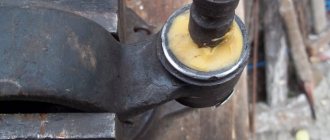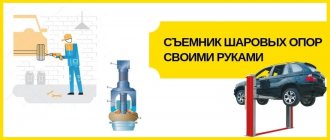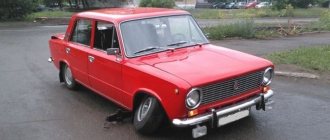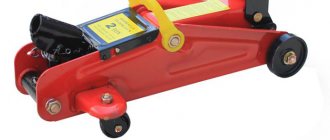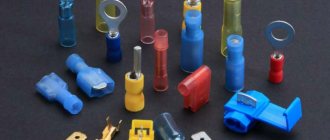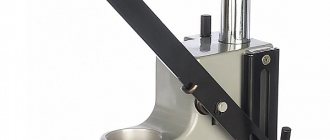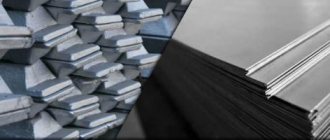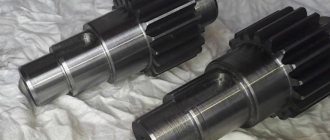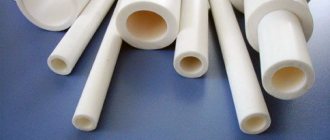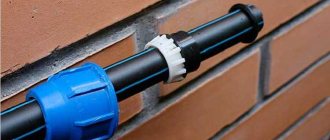In our workshop, we were able to combine advanced technologies, high-quality raw materials and the experience of our designers, which allowed us to increase the service life of repaired parts.
When repairing and diagnosing a car's chassis, we often find faulty rods, ends, ball joints and silent blocks.
The client has a question about where to quickly and inexpensively buy new auto parts of good quality. In the HydroCenter workshop, we solved this problem by purchasing branded equipment for repairing ball joints and ball joints.
Steering rod before restoration
Steering rod after restoration
We can restore ball joints in suspension and steering parts of passenger cars.
What is a ball joint
It is a hinge that works like an organic joint. In other words, there is a ball inside the mechanism that allows the base to move in different planes. The ball is located in the place where the lever is fixed to the hub, and performs a connecting function. Usually on foreign cars the number of supports is limited to one per wheel, but on Mercedes-Benz and some other models there are two of them, like on Zhiguli.
This is what the ball consists of:
- iron rod or finger;
- rounded fist;
- pressure washer or cotter pin;
- anther;
- polymer cup;
- rolling;
- cylindrical body.
The design is simple, but the unit is one of the most important parts of the vehicle's chassis.
Ball joint device
Ball joint life
The service life of ball joints depends directly on the polymer liner, which is located inside the mechanism. When it breaks due to dirt and loads, the iron finger begins to move freely, breaking the soft parts around it. Characteristic knocking sounds appear, especially on holes and bumps. Dirt and foreign objects get inside due to the rupture of the boot - it is one of the first to be damaged in the ball joint.
On foreign cars equipped with front-wheel drive, the joints last approximately 150–180 thousand kilometers. However, they need to be checked more often - preferably every 30-40 thousand km, if the car has driven more than 100 thousand km. On new machines, parts should be inspected during the fifth maintenance.
Causes of wear
Thus, the causes of ball wear are:
- Wear and tear due to natural causes. Parts that are not manufactured according to all the rules of technology are damaged ahead of time. They cost much less than original spare parts, so they are actively purchased by car owners. However, after approximately 70-100 thousand kilometers, these balls wear out. If the element is influenced by additional factors (lack of care, frequent driving through mud, constant high speeds, sudden temperature changes), then the resource is reduced even more.
- Anther. It is also called a protector, implying the main function is to prevent dirt, sand and moisture from entering. The car owner needs to inspect the element from time to time, because if it breaks, it will inevitably cause damage to the hinge. Torn anthers should be urgently replaced by applying a special lubricant to the new consumable.
- Increased load. Aggressive and fast driving puts a lot of stress on the ball joint. In Russia, we have very few roads where you can accelerate to 150-200 km/h, so you need to drive extremely carefully. If the wheel falls into a hole, it will cause the ball to break, since it takes the blow first. This also happens when the driver transports a heavy load in a car or tows another car that does not meet the permissible weight standards.
- Drying of lubricant. There should always be lubricant inside the ball joint. It may disappear due to drying or evaporation, which occurs due to damage to the anther. You need to regularly add lithol using a syringe or a special tool.
Popular brands:
Infiniti QX70, Mercedes-Benz C–Class, Renault Laguna
To avoid early ball failures, do not skimp on purchasing an original, high-quality support. It is better not to consider Chinese analogues at a low price at all - they last no more than 20-30 thousand km of car mileage.
One of the ways to determine that a ball joint has failed involves inspecting the boot.
Torn ball joint boot
Device and purpose
The ball joint allows for a reliable movable connection between the wheel hub and the suspension arm. The assembly includes a housing, a ball pin , and an insert made of plastic. The body most often has a welded structure - two parts with a stamped spherical recess for the finger are connected using spot welding.
Essentially, this element is a thick-walled glass made of metal into which an insert with a finger is then inserted. To make the housing structure non-separable, its edges are flared. Often the liner is not manufactured separately, but the area between the walls of the housing and the ball surface of the finger is filled with a special polymer material. To protect the unit from dirt and water, a boot is placed on top.
It should be noted that active wear of the ball joint begins after the boot is damaged . Until this happens, the unit is practically not subject to wear. Thus, if you monitor the condition of this element and replace it in a timely manner, you can significantly increase the life of the unit.
However, it is worth remembering that the weld joints do not have sufficient tightness and even with an intact boot, water can get inside. To avoid this, the case should be filled with lithol.
Symptoms of a problem
It’s good that there are signs by which it is possible to determine the beginning of wear or damage to the ball. Below we describe the most common symptoms:
- knocking noise from under the front wheels when driving over potholes and bumps - as a rule, this indicates wear of the rod or lack of lithol;
- wobbling of the car on the highway - usually caused by the free movement of the finger (the car yaws the more, the higher the speed);
- loss of wheel alignment - this occurs on the wheel where the support fails (checked at a stand in a car service center, such changes are not noticeable to the eye);
- uneven tire wear - if the wheel alignment is lost, then the tires wear unevenly, because the wheel does not stand level to the surface of the tire, but at an angle;
- creaking when turning the steering wheel is a rare symptom for a ball joint, but it also occurs;
- change in direction of movement during braking - the car usually turns a little to one side, just on the side of the broken hinge (at the same time, clicks are heard).
If you notice these signs of wear, take immediate action. Go to the nearest car service center and have the ball joints diagnosed.
How to determine whether a ball joint is faulty
The best option would be to visit a car service center, where there is the necessary equipment and specialists. True, not everyone is happy with this option, because every time you have to pay for the service - they charge little for diagnosing a joint, but low-income Russians can afford it, it’s still expensive.
The second way to determine wear is to listen for yourself to how the ball reacts to swinging. In this case, you need an assistant who will rock the car from side to side, perpendicular to the movement. You must listen to the knocks and determine where they are coming from.
Another way you can understand that it’s time to change the ball joint: jack up the car, squeeze the brake and start pumping the wheel away from you and towards you. Knocks will indicate a problem with the support. You can also use a pry bar. The car is jacked up again, after which the flat end of the mounting blade is placed between the axle pin and the lever. The assistant turns the steering wheel, you put pressure on the crowbar, and the play makes itself felt.
Checking the ball joint
Now you have learned how to determine the malfunction, which does not prevent you from regularly checking the hinge for serviceability. If this doesn’t work, then contact a professional service station.
How repairs are carried out
When repairing a ball or steering linkage, we use proprietary fast-hardening plastic, which liquefies at a temperature of 190 - 200C° and penetrates into the ball joint under high pressure.
While the plastic is fluid, it fills all the cavities and voids in the ball joint that caused knocking and discomfort when driving.
It is recommended to use repaired ball joints after 3 hours of plastic polymerization and restoration of its standard lubricating properties.
Plastic used in repairs
Steering rod after restoration
Warranty:
The use of branded equipment and high-quality materials allows us to provide a long-term guarantee for repaired ball joints and silent blocks up to 12 months
Ball joint repair
Is it worth repairing a damaged part when changing ball joints in any case is easier and safer. Moreover, the part is inexpensive (only 500-1000 rubles, depending on the model) and this does not need to be done often. And on many modern foreign cars this unit must be replaced as an assembly.
It is better to replace in pairs, even if only one ball is knocking. The reason is simple - you will have to pay the repairman again for the service, since the second support will soon wear out 100 percent. So why pay extra to the master when you can do everything at once and save money. In addition, after this procedure, a mandatory alignment adjustment is carried out, which also costs money.
Now specifically for repairs. It involves replacing worn parts of the support with new ones. Usually the polymer insert and protector are replaced, but recently repair kits with other spare parts have appeared in stores. However, the quality of these components is not always high; low-grade “China” products are often sold under well-known names.
The movable hinge is a suspension element that cannot be ignored. A faulty ball joint can lead to dire consequences, and the driver himself will be to blame for missing the initial signs of damage. This is what a breakdown threatens: a car wheel turns outward, which leads to an accident at high speed. It is impossible to stop the car; due to inertia, it will travel some distance, and it is unknown what it will hit.
Suspension diagnostics and repair
The most important component in a wheel suspension is the wheel bearing. It is this bearing that holds the wheel and allows it to rotate. This node is subject to the highest loads. Wheel bearings directly affect operational safety and provide stability on the road. Despite the fact that wheel bearings have different designs (cone, ball, adjustable and non-adjustable), the failure process is similar for all.
Most often, bearing failures begin with increased dynamic load or incorrect adjustment. This could be a hole or unevenness in the road, a wheel touching a road curb when parking, or untimely or incorrect adjustment, if the bearing design allows this. All bearings are made of hard steel alloys, which are hardened and polished. Under high dynamic loads, the strongest part (for example, a ball) deforms another, softer part (for example, a bearing race). The ball presses a small hole on the holder. When the bearing rotates, all the balls in the row fall into the formed hole and lead to an increase in its size and damage to the balls themselves. This process is not reversible. Rotation of a bearing with such damage leads to its overheating. As a result, the lubricant boils away, the hardened metal is “relaxed” and the wear process accelerates exponentially. During operation, the defect manifests itself as a hum. As the mileage increases, the noise when driving increases. If you do not pay attention to the extraneous noise that appears, then there will also be play in the bearing, which allows the wheel to dangle in a plane perpendicular to the movement, thereby leading to loss of stability and violation of the wheel alignment angles. We strongly do not recommend neglecting faulty wheel bearings. It is not safe.
At the Avtobam Technical Center, specialists will quickly determine the source of extraneous noise when driving and offer options for speedy repairs. Do not assume that replacing a wheel bearing is an expensive operation that requires significant material costs. Nowadays the auto parts market offers a sufficient variety of worthy replacement parts, such as TNT and SNR. These bearing manufacturers allow you to save a lot on the cost of spare parts without sacrificing quality.
